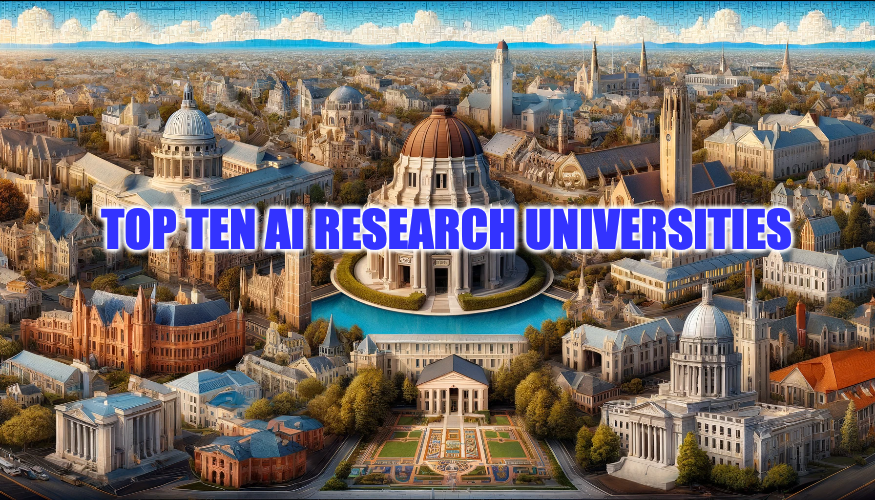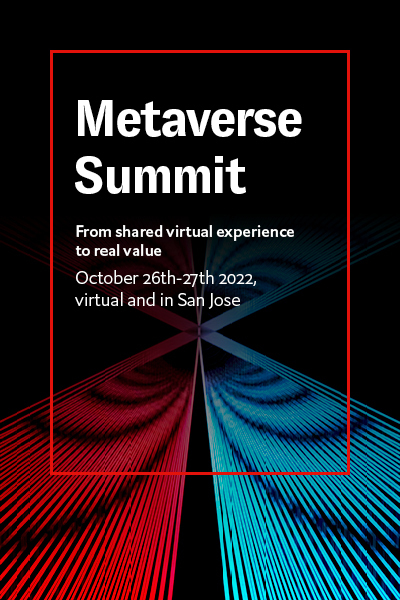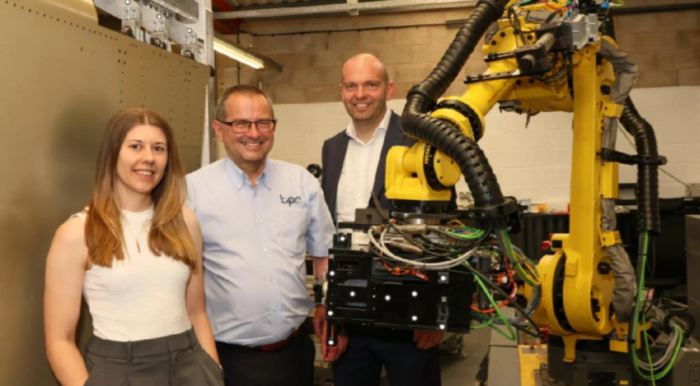- Last modified: May 16, 2024
What are some of the world’s best universities in artificial intelligence research?
Turns out, there are a lot!
Using research output, research output-per-student and research quality as a guide, the AI Insider is publishing the following as a snapshot of some of the universities that are world’s leaders in artificial intelligence, machine learning and large language models. The list was compiled through a series of online tools focused on research output (the number of AI papers) and research quality (H-index). Because research output can be shaped by the size of the student population, efforts were made to create a students-per-student ratio. For reference a rough estimate or the university’s h-index, via ScholarGPT, and then a student ratio was shaped from that. The idea is to give some idea of the overall research quality, in addition to some of the more obvious statistics.
Final note, the order of the list is determined by that student output ratio, but it shouldn’t be seen as a better than, worse than list.
Here’s the list!
Massachusetts Institute of Technology (MIT)
- Student Population: 11,520
- Number of Papers: 1,200
- Ratio (Students per Paper): 9.60
- H-index: 230
- Student H-index: 0.0200
Carnegie Mellon University is a global leader in artificial intelligence research, supported by its strong collaborations across fields and extensive research facilities such as the Robotics Institute, the Language Technologies Institute, and the Machine Learning Department. The Robotics Institute, one of the largest robotics research organizations in the world, focuses on various aspects of robotics including autonomous vehicles, robot learning, and manipulation. The Language Technologies Institute pioneers advancements in natural language processing, speech processing and machine translation, reflecting CMU’s strong focus on human-computer interaction, or HCI.
CMU’s Machine Learning Department, part of the School of Computer Science, is dedicated to understanding the nature of learning processes and developing the next generation of AI algorithms. This department is involved in groundbreaking research across various domains of AI, including deep learning, reinforcement learning, and the theoretical foundations of machine learning. Notable researchers at CMU include Tom Mitchell, the founding chair of the Machine Learning Department, and Manuela Veloso, known for her work in autonomous robots and co-robotics. CMU also nurtures initiatives like the CMU AI Research (CAIR) group to integrate AI research and innovation across different departments and schools within the university.
For further information, you can explore the Robotics Institute and the Machine Learning Department at CMU.
- Student Population: 15,878
- Number of Papers: 1,150
- Ratio (Students per Paper): 13.81
- H-index: 220
- Student H-Index: 0.0139
Stanford University has a legacy of premier AI research with extensive programs and initiatives across various departments and dedicated institutes such as the Stanford Artificial Intelligence Laboratory (SAIL) and the Institute for Human-Centered Artificial Intelligence (HAI). SAIL, in particular, has been a center of excellence for AI research since its inception in 1962, focusing on deep learning, robotics, and human-AI interaction. These research activities are supported by the broader Stanford community through initiatives like the AI4ALL summer program, which aims to increase diversity in the field of AI.
Additionally, HAI emphasizes interdisciplinary research and human-centered AI technologies, aiming to enhance the human condition through AI innovations. This includes healthcare diagnostics, environmental sustainability, and public policy. Noted researchers such as Fei-Fei Li, who is known for her work in computer vision and cognitive neuroscience, and Andrew Ng, co-founder of Google Brain and a proponent of democratizing AI education, are prominent figures in Stanford’s AI community. The university also hosts numerous AI-related clubs and organizations, fostering a collaborative environment for students to engage in innovative projects and research.
For more detailed information, you can visit the Stanford Artificial Intelligence Laboratory and the Stanford Institute for Human-Centered Artificial Intelligence.
- Student Population: 23,247
- Number of Papers: 950
- Ratio (Students per Paper): 24.47
- H-index: 190
- Student H-index: 0.0082
The University of Cambridge is renowned for its pioneering research in artificial intelligence through various dedicated institutes and centers such as the Cambridge Centre for AI in Medicine (CCAIM) and the Machine Learning Group at the Department of Engineering. The CCAIM is focused on developing AI technologies to revolutionize the biomedical sector, employing machine learning to facilitate early diagnosis, drug discovery, and personalized medicine. Meanwhile, the Machine Learning Group conducts fundamental research in statistical machine learning and builds new methods for predictive modeling that are used across a range of applications, including information retrieval and natural language understanding.
Cambridge’s Leverhulme Centre for the Future of Intelligence (CFI) explores the impact of AI on society, studying ethical and theoretical dimensions to ensure AI developments benefit all of humanity. Notable scholars include Professor Zoubin Ghahramani, a world leader in machine learning known for his work on probabilistic models and Bayesian approaches to machine learning.
For more information, you can visit Cambridge Centre for AI in Medicine and the Machine Learning Group.
- Student Population: 17,690
- Number of Papers: 700
- Ratio (Students per Paper): 25.27
- H-index: 140
- Student H-index: 0.0079
Imperial College London is another AI research leader, both in the UK and worldwide. Its Data Science Institute and the Department of Computing are integral part of the AI leadership. The Data Science Institute at Imperial investigates the use of big data, machine learning, and AI across various disciplines, including healthcare, finance and environmental science. This institute is equipped with a Data Observatory, which provides vast amounts of data for analysis and visualization, supporting groundbreaking AI research.
The Department of Computing is another pillar of AI research at Imperial, with specializations in machine learning, visual information processing, and robotics. It is involved in developing theoretical foundations and applications of AI that address some of the most pressing global challenges. Notable researchers include Professor Murray Shanahan, who served as a scientific advisor on the film “Ex Machina” and contributes extensively to the study of cognitive robotics and AI ethics, and Dr. Aldo Faisal, whose work on brain-machine interfaces and computational neuroscience bridges the gap between AI and human health.
For more information, you can visit the Data Science Institute and the Department of Computing.

- Student Population: 22,193
- Number of Papers: 850
- Ratio (Students per Paper): 26.11
- H-index: 170
- Student H-index: 0.0077
ETH Zurich is a powerhouse in the field of artificial intelligence, hosting several research groups and initiatives focused on various aspects of AI and machine learning. The Data Analytics Lab at ETH Zurich is particularly prominent, where researchers develop algorithms that allow computers to learn from and make predictions on data. This lab tackles a broad spectrum of applications ranging from genomics and systems biology to social science and economics.
Another significant entity within ETH Zurich is the Artificial Intelligence Center (AIC), which fosters interdisciplinary research and collaboration across various domains of AI. The center aims to integrate AI technologies in fields like robotics, computer vision, and natural language processing to solve complex real-world problems. ETH Zurich is also home to notable researchers such as Thomas Hofmann, who works on machine learning, data mining, and information retrieval, and Andreas Krause, who focuses on learning algorithms for complex distributions in networked systems.
For more detailed information, you can visit the Data Analytics Lab and the ETH AI Center.
- Student Population: 24,000
- Number of Papers: 900
- Ratio (Students per Paper): 26.67
- H-index: 180
- Student H-index: 0.0075
The University of Oxford excels in AI research with its Oxford Robotics Institute (ORI) and the Oxford Internet Institute (OII), along with the Deep Medicine program which utilizes machine learning to improve healthcare outcomes. ORI is at robotics research leader, developing innovative solutions and technologies in mobile autonomy, machine vision, and robotic grasping. The OII investigates the social implications of artificial intelligence and the internet, focusing on policy and ethical considerations of digital technologies.
Oxford’s Deep Medicine program harnesses AI to tailor medical treatment to individual patients, significantly advancing the fields of personalized medicine and diagnostics. Distinguished researchers include Professor Nick Bostrom, known for his work on AI existential risk, and Professor Mike Wooldridge, who has made significant contributions to the theory and practice of multi-agent systems.
To explore more about their initiatives, check out the Oxford Robotics Institute and the Oxford Internet Institute.

University of California, Berkeley (UC Berkeley)
- Student Population: 42,327
- Number of Papers: 1,100
- Ratio (Students per Paper): 38.48
- H-index: 200
- Student H-index 0.0047
UC Berkeley stands out as a hub for AI research with its innovative programs and centers like the Berkeley Artificial Intelligence Research (BAIR) Lab, the Center for Human-Compatible Artificial Intelligence (CHAI), and initiatives such as the Berkeley DeepDrive (BDD) industry partnership. BAIR unites UC Berkeley researchers across the areas of computer vision, machine learning, natural language processing, planning, and robotics. Its diverse projects are aimed at developing and advancing the theories and applications that enable machines to sense, learn from, and interact with the world.
CHAI, another pivotal entity at UC Berkeley, specifically focuses on the fundamental and applied research necessary to ensure that AI systems are beneficial to humanity. This includes tackling ethical considerations and long-term impacts of AI technology. Berkeley’s collaboration with industry through the Berkeley DeepDrive initiative, which looks into the intersection of AI with automotive technology, underscores its commitment to applying AI research in solving real-world problems. Prominent figures at UC Berkeley include researchers like Stuart Russell, a pioneer in artificial intelligence and advocate for incorporating ethical considerations into AI development, and Pieter Abbeel, who specializes in robotics and deep reinforcement learning.
For more detailed information, you can visit the Berkeley Artificial Intelligence Research (BAIR) Lab and the Center for Human-Compatible Artificial Intelligence (CHAI).
-
- Student Population: 50,000
- Number of Papers: 800
- Ratio (Students per Paper): 62.50
- H-index: 160
- Student H-index: 0032
Tsinghua University in Beijing is one of China’s premier institutions for higher education and a leader in AI research, hosting multiple research centers and initiatives that explore the frontiers of artificial intelligence. The Tsinghua University Institute for Artificial Intelligence, launched in partnership with major tech companies, is dedicated to advancing AI research and development. The institute focuses on areas such as deep learning, computer vision, and AI ethics, with the aim to foster global collaboration and innovation.
We should also note the State Key Laboratory of Intelligent Technology and Systems at Tsinghua integrates AI technologies across various applications, including robotics, pattern recognition, and cognitive computing. Notable figures in AI at Tsinghua include Bo Zhang, a pioneer in machine learning and AI theory, and Sun Maosong, who specializes in natural language processing and information retrieval.
For more information, you can explore the Tsinghua University Institute for Artificial Intelligence.
-
- Student Population: 93,081
- Number of Papers: 750
- Ratio (Students per Paper): 124.11
- H-index: 150
- Student H-index: 0.0016
The University of Toronto is a global leader in AI, particularly noted for its contributions to deep learning and neural networks. The university’s Vector Institute for Artificial Intelligence attracts internationally recognized faculty members and researchers focused on deep learning and machine learning innovations. The institute collaborates with both the academic community and industry to drive research that can be translated into real-world applications.
U of T’s Department of Computer Science also contributes extensively to AI research, with projects spanning areas such as machine perception, computational linguistics, and bioinformatics. Renowned researchers include Geoffrey Hinton, known as the “godfather of deep learning,” who has made profound contributions to neural networks and cognitive psychology.
For further details, you can visit the Vector Institute’s website and the University of Toronto’s Department of Computer Science.
Limitations
The limitations of the approach are considerable. While there’s no doubt that the universities on this list are global leaders at artificial intelligence, creating a list of ten universities from the thousands of institutions that are engaged in AI research and education is subject to many variables. First, the initial keyword search — combinations artificial intelligence, machine learning and llm — with Google Scholar, Scholar GPT, Google search and Resonance Intelligence Platform assets will most certainly be too limited. AI research fluctuates and new leaders may be behind from this list, but are gaining ground rapidly. AI leadership includes research, education (teaching) and partnerships with industry. Research output is just one of these factors. The quality of research — and its impact in the real world — is similarly hard to predict. The H-index was used as a rough guide for research quality, rather than a singular rate of research output. Bigger schools tend to top these lists, which skews the list based on output toward those institutions. Finally, school populations size — which includes all students — may not be thoroughly representative of AI research efforts.
Key:
- Student Population: Total number of students enrolled.
- Number of Papers: Estimated number of research publications in AI, ML, and LLM over the past ten years.
- Ratio (Students per Paper): Calculated by dividing the student population by the number of papers. (lower is better)
- H-index: A rough measure of the productivity and citation impact of the publications. (higher is better)
- Student H-index: A rough measure of H-index divided by student population (higher is better)







